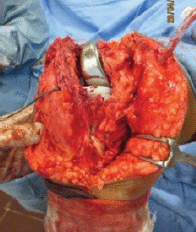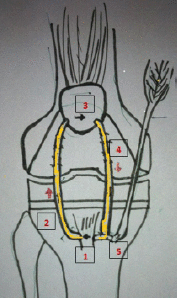Management of Patellar Tendon Rupture after Total Knee Arthroplasty using Hamstring graft: A Case Report
- PMID: 30167415
- PMCID: PMC6114200
- DOI: 10.13107/jocr.2250-0685.1050
Management of Patellar Tendon Rupture after Total Knee Arthroplasty using Hamstring graft: A Case Report
Abstract
Introduction: The disruption of extensor mechanism during or after total knee arthroplasty is a rare but disabling complication for the patients. The results of various methods of managing patellar ligament rupture are not predictable and favorable.
Case report: We report a case of patellar ligament rupture which occurred 6 months after the primary total knee replacement. It was managed satisfactorily using hamstring graft and minimal implant.
Conclusion: Simple and easily reproducible technique for patellar tendon reconstruction that can be performed by surgeons not routinely performing ligament reconstruction gives favorable outcome.
Keywords: Extensor mechanism rupture; Hamstring graft; Patellar tendon repair; Total knee arthroplasty.
Conflict of interest statement
Conflict of Interest: Nil
Figures











Similar articles
-
Surgical repair of chronic patellar tendon rupture in total knee replacement with ipsilateral hamstring tendons.Knee Surg Sports Traumatol Arthrosc. 2016 Oct;24(10):3183-3190. doi: 10.1007/s00167-014-3448-9. Epub 2014 Nov 26. Knee Surg Sports Traumatol Arthrosc. 2016. PMID: 25423873
-
Patellar tendon versus hamstring tendon autografts for anterior cruciate ligament reconstruction: a randomized controlled trial using similar femoral and tibial fixation methods.Am J Sports Med. 2009 Oct;37(10):1946-57. doi: 10.1177/0363546509339577. Epub 2009 Aug 14. Am J Sports Med. 2009. PMID: 19684298 Clinical Trial.
-
Hamstring tendon versus patellar tendon anterior cruciate ligament reconstruction using biodegradable interference fit fixation: a prospective matched-group analysis.Am J Sports Med. 2005 Sep;33(9):1327-36. doi: 10.1177/0363546504273488. Epub 2005 Jul 7. Am J Sports Med. 2005. PMID: 16002490
-
Outcomes of Anterior Cruciate Ligament Reconstruction in Females Using Patellar-Tendon-Bone versus Hamstring Autografts: A Systematic Review and Meta-Analysis.J Knee Surg. 2019 Aug;32(8):770-787. doi: 10.1055/s-0038-1669916. Epub 2018 Sep 13. J Knee Surg. 2019. PMID: 30212919
-
Dislocation of a constrained total knee arthroplasty with patellar tendon rupture after trivial trauma.Chin J Traumatol. 2015;18(4):241-4. doi: 10.1016/j.cjtee.2015.01.007. Chin J Traumatol. 2015. PMID: 26764549 Review.
Cited by
-
Patellar complications following total knee arthroplasty: a review of the current literature.Eur J Orthop Surg Traumatol. 2019 Dec;29(8):1605-1615. doi: 10.1007/s00590-019-02499-z. Epub 2019 Jul 13. Eur J Orthop Surg Traumatol. 2019. PMID: 31302764 Review.
-
Total knee revision arthroplasty: comparison between tibial tubercle osteotomy and quadriceps snip approach. Complication rate.Acta Biomed. 2020 May 30;91(4-S):146-151. doi: 10.23750/abm.v91i4-S.9705. Acta Biomed. 2020. PMID: 32555089 Free PMC article.
References
-
- Cadambi A, Engh GA. Use of a semitendinosus tendon autogenousgraftforrupture of the patella ligament after total knee arthroplasty. A report of seven cases. J Bone Joint Surg Am. 1992;74:974–9. - PubMed
-
- Emerson RH, Jr, Head WC, Malinin TI. Reconstruction of patellartendon rupture after total knee arthroplasty with and extensormechanism allograft. Clin Orthop Relat Res. 1990;260:154–61. - PubMed
-
- Emerson RH, Jr, Head WC, Malinin TI. Extensor mechanism reconstruction with an allograft after total knee arthroplasty. Clin Orthop Relat Res. 1994;303:79–85. - PubMed
-
- Lynch AF, Rorabeck CH, Bourne RB. Extensor mechanism complications following total knee arthroplasty. J Arthroplasty. 1987;2:135–40. - PubMed
-
- Dobbs RE, Hanssen AD, Lewallen DG, Pagnano MW. Quadriceps tendon rupture after total knee arthroplasty: Prevalence, complications, and outcomes. J Bone Joint Surg Series A. 2005;87:37–45. - PubMed
Publication types
LinkOut - more resources
Full Text Sources
